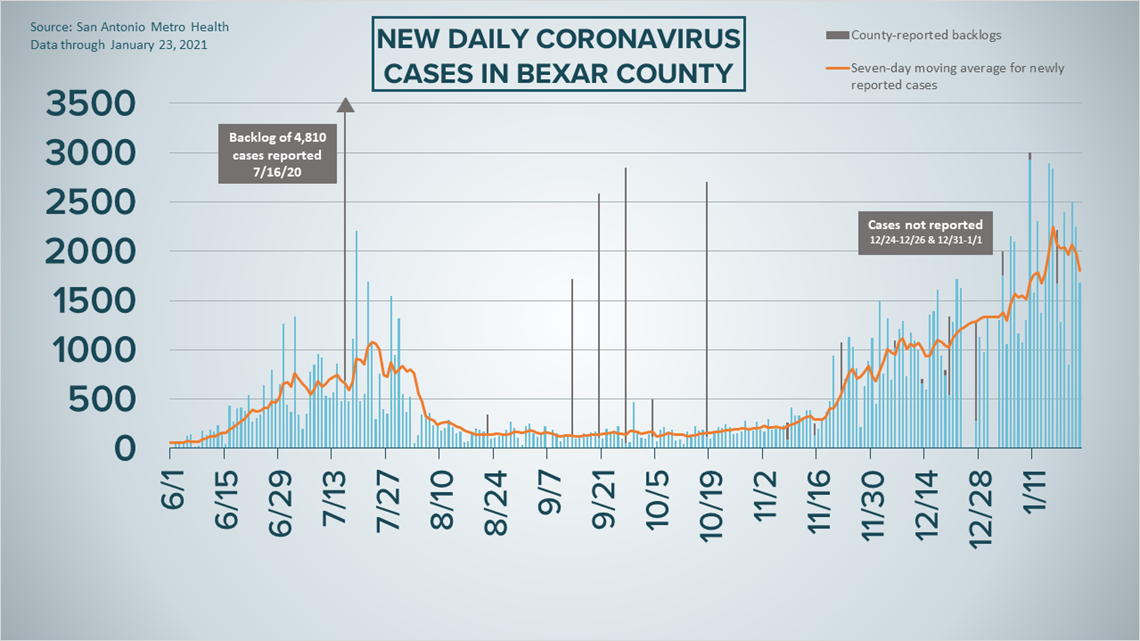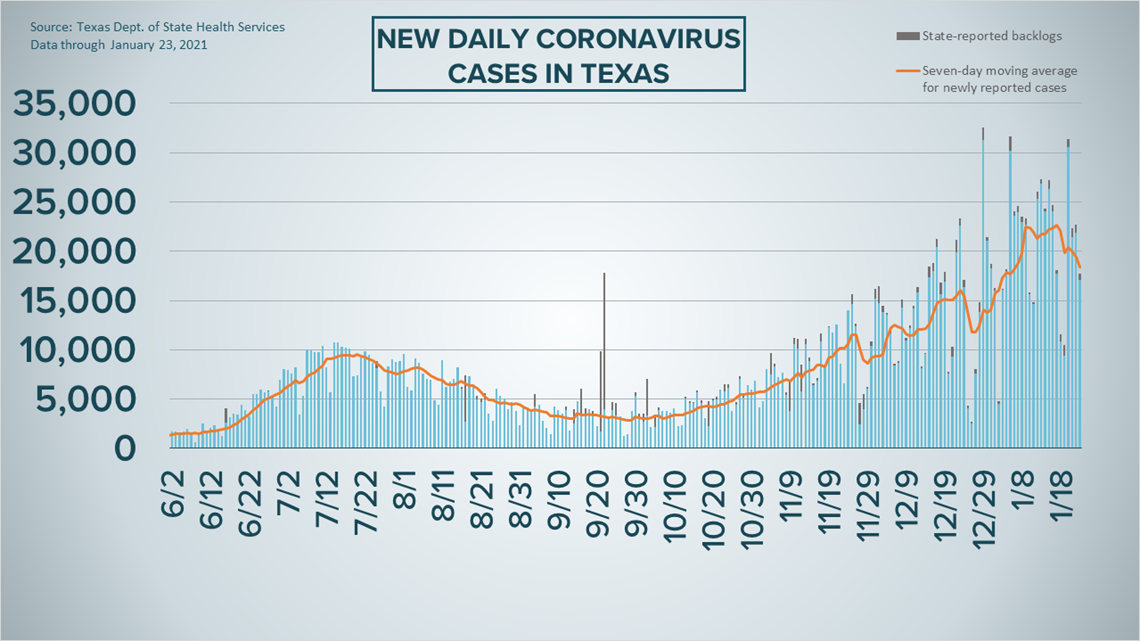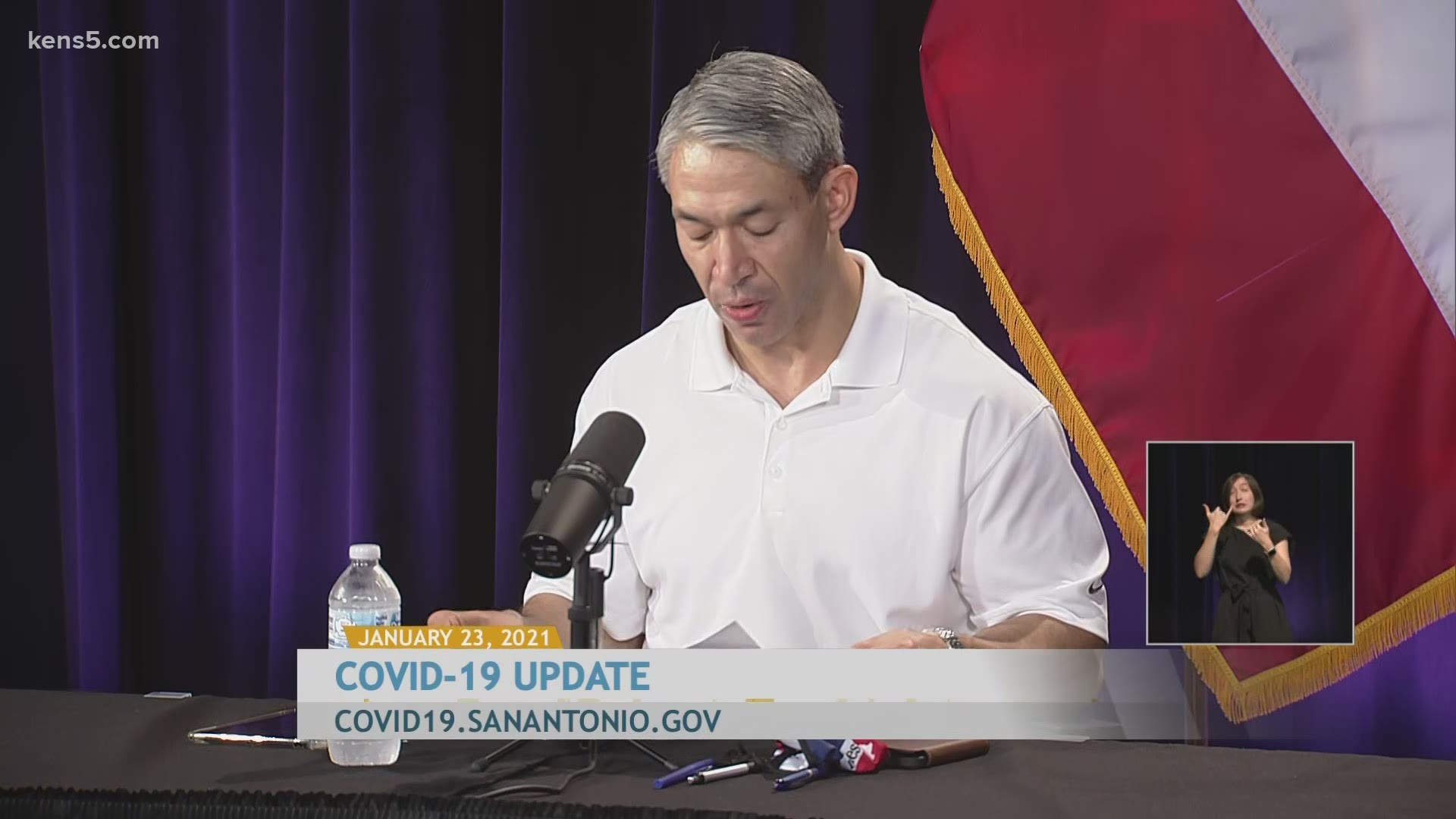SAN ANTONIO — We're tracking the latest numbers from the coronavirus pandemic in San Antonio and across Texas. Here are the latest numbers reported by Bexar and surrounding counties:
- Bexar County: On Saturday, 1,684 new cases were reported, bringing the total number of cases to 159,519. Eighteen new deaths were also reported, raising the local death toll to 1,892.
- Hays County: On Friday, officials reported 77 new cases in the county and 6 additional COVID-related fatalities. As of Friday, there are a total of 13,915 lab-confirmed local cases, while the death toll rose to 171. Officials estimate 11,047 residents have recovered, while 2,697 are still ill with the virus.
- Comal County: On Friday, officials reported 85 new cases and 0 additional COVID-related fatalities. There are a total of 7,570 cases, including 4,220 confirmed and 3,239 probable cases, while 228 county residents have died due to COVID-19 complications. The county estimates 6,617 residents have recovered, while 725 are still ill with the virus.
More county case information is available through the Texas Department of Health Services COVID-19 dashboard.
How Bexar County is trending
We've tracked how many coronavirus cases have been confirmed in Bexar County from the time officials began reporting cases in March 2020. The graphic below shows the number of cases since June and charts those daily case numbers along a 7-day moving average to provide a more accurate picture of the overall coronavirus case curve in our area and the direction we're trending amid the pandemic.
On Saturday, Mayor Ron Nirenberg reported an additional 1,684 coronavirus cases in Bexar County, the lowest daily tally since Wednesday's 850 diagnoses. In all, 159,519 county residents have been diagnosed with COVID-19 since the pandemic began.
With the relatively lower number of cases (compared to previous days), the seven-day rolling average dropped from 1,971 on Friday to 1,806 on Saturday.
Nirenberg also reported 18 more virus-related deaths, capping off one of the community's deadliest weeks as it pertains to COVID-19. Local leaders reported at least 10 deaths from virus complications in each of the past five days, and at least 17 in each of the past four.
At least 1,892 county residents have died from coronavirus complications.


For the fifth straight day, coronavirus hospitalizations fell at local hospitals; on Saturday, the number of concurrent patients receiving treatment for their victims stood at 1,375. On Monday, the number was 1,520.
Both the number of patients on ventilators (252) and the number of patients in intensive care (414) remained the same from Friday.


Coronavirus in Texas
The total number of novel coronavirus cases in the state since the pandemic began grew by 17,672 on Saturday, according to the Texas Department of State Health Services. That total includes 13,717 new confirmed cases, 3,327 new probable cases, and 628 cases attributed to backlogs not previously reported in the state's total (more details can be found at the top of this page).
Saturday's figures bring the total number of Texans diagnosed with COVID-19 to nearly 2.229 million.


Meanwhile, state health authorities also reported 407 new virus-related deaths. Texas has now marked at least four straight days of at least 400 fatalities, and at least 34,114 Texans have died from COVID-19 complications.
The number of Texans receiving treatment at hospitals for coronavirus symptoms dropped by 35 overall patients. On Saturday, the concurrent total stood at 13,309.
The state estimates that about 1.798 million Texans have recovered, while 380,904 Texans remain ill with COVID-19.
The latest update from the Texas Education Agency showed that there have been at least 128,973 cumulative cases among staff and students across the state through January 17. That number comprises 81,118 positive student cases and 47,885 staff cases. More information can be found here.
The TEA releases new data on school cases on Fridays.
Latest Coronavirus Headlines
- Wuhan returns to normal as world still battling pandemic
- COVID-19 Vaccine Tracker: Fast facts and how to participate in Phase 1B distribution in San Antonio
- New research finds higher doses of blood thinners help some COVID-19 patients
- 'Expect announcements related to Fiesta in the next couple of weeks,' Nirenberg says after Oyster Bake cancellation
- University Health extends COVID-19 vaccine appointment schedule as high demand continues
- Longtime BCSO deputy dies from apparent coronavirus complications, officials say
- Biden signs executive orders for stopgap help as talks start on big aid plan
- 'It's 1.9 trillion rays of sunshine at a very dark time': SA leader reacts to Pres. Biden's proposed pandemic relief package
- Coronavirus guidelines now the rule at White House
- Dave Chappelle tests positive for COVID-19; shows canceled
Coronavirus symptoms
The symptoms of coronavirus can be similar to the flu or a bad cold. Symptoms include fever or chills, cough, shortness of breath or difficulty breathing, fatigue, muscle or body aches, headache, new loss of taste or smell sore throat, congestion or runny nose, nausea or vomiting, and diarrhea, according to the Centers for Disease Control.
Most healthy people will have mild symptoms. A study of more than 72,000 patients by the Centers for Disease Control in China showed 80 percent of the cases there were mild.
But infections can cause pneumonia, severe acute respiratory syndrome, kidney failure, and even death, according to the World Health Organization. Older people with underlying health conditions are most at risk.
Experts determined there was consistent evidence these conditions increase a person's risk, regardless of age:
- Chronic kidney disease
- COPD (chronic obstructive pulmonary disease)
- Obesity (BMI of 30 or higher)
- Immunocompromised state (weakened immune system) from solid organ transplant
- Serious heart conditions, such as heart failure, coronary artery disease, or cardiomyopathies
- Sickle cell disease
- Type 2 diabetes
The CDC believes symptoms may appear anywhere from two to 14 days after being exposed.
Human coronaviruses are usually spread...
- Between people who are in close contact with one another (within about 6 feet).
- Through respiratory droplets produced when an infected person coughs, sneezes or talks. These droplets can land in the mouths or noses of people who are nearby or possibly be inhaled into the lungs.
- Some recent studies have suggested that COVID-19 may be spread by people who are not showing symptoms.
Help stop the spread of coronavirus
- Stay home when you are sick.
- Eat and sleep separately from your family members
- Use different utensils and dishes
- Cover your cough or sneeze with your arm, not your hand.
- If you use a tissue, throw it in the trash.
Find a Testing Location
City officials recommend getting a COVID-19 test if you experience fever or chills, cough, shortness of breath or difficulty breathing, fatigue, muscle or body aches, headache, new loss of taste or smell, sore throat, congestion or runny nose, nausea or vomiting, or diarrhea.
San Antonio operates several no-cost testing locations, including two walk-up locations open Monday-Sunday from 10 a.m. until 2 p.m.:
Cuellar Community Center
5626 San Fernando St.
San Antonio, TX 78237
Ramirez Community Center
1011 Gillette Blvd.
San Antonio, TX 78224
Additionally, Freeman Coliseum offers drive-through no-cost testing from Monday through Sunday between 9 a.m. and 4 p.m. An appointment is required and can be made either online or by calling (833) 213-0643.
Here's a Testing Sites Locator to help you find the testing location closest to you in San Antonio.

